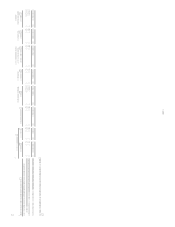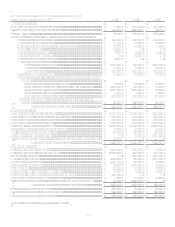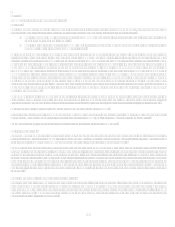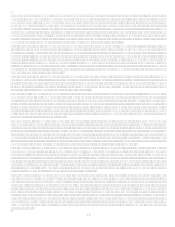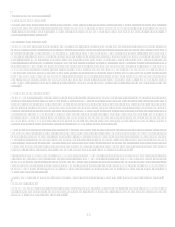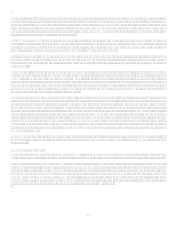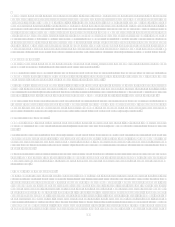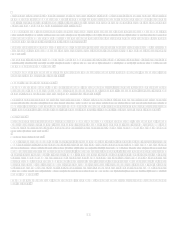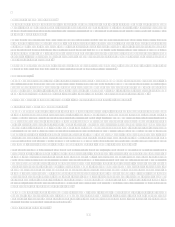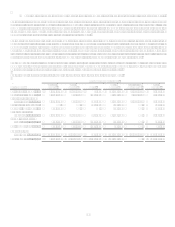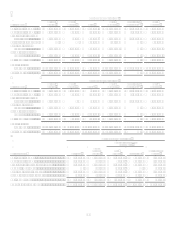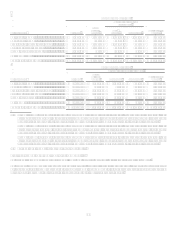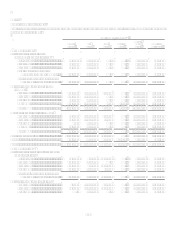Capital One 2008 Annual Report Download - page 110
Download and view the complete annual report
Please find page 110 of the 2008 Capital One annual report below. You can navigate through the pages in the report by either clicking on the pages listed below, or by using the keyword search tool below to find specific information within the annual report.92
Consumer loan balances that are expected to be securitized in the next three months are accounted for as held for sale. The loans that
have been identified as held for sale are carried at the lower of aggregate cost or fair value and an allowance for loan losses is not
provided for these loans. Management believes its ability to reasonably forecast the amount of existing consumer loans that should be
accounted for as held for sale is limited to three months from the balance sheet date because of the short-term nature of the assets, the
revolving nature of the securitization structures and the fact that securitizations that occur beyond three months will involve a
significant proportion of consumer loans that have not yet been originated. The Company continues to include these loans in loans
held for investment because separate classification in the Reported Consolidated Balance Sheets and related impacts to the Reported
Consolidated Statements of Income is considered immaterial to the Companys financial statements. Cash flows associated with loans
that are originated with the intent to hold for investment are classified as investing cash flow, regardless of a subsequent change of
intent. Certain mortgage loans associated with the GreenPoint shut down, which were previously categorized as held for sale and
marked at the lower of aggregate cost or fair value, were transferred to held for investment at December 31, 2007. Cash flows
associated with these loans were included in operating cash flows. All other loans are reported at their principal amounts outstanding.
Nonperforming Assets
Nonperforming assets include nonaccrual loans, impaired loans, certain restructured loans on which interest rates or terms of
repayment have been materially revised, foreclosed and repossessed assets.
Commercial loans, consumer real estate and auto loans are placed in nonaccrual status at 90 days past due or sooner if, in
managements opinion, there is doubt concerning full collectibility of both principal and interest. All other consumer loans and small
business credit card loans are not placed in nonaccrual status prior to charge-off.
At the time a loan is placed on nonaccrual status, interest and fees accrued but not collected through the end of the previous quarter are
systematically reversed and charged against income. Interest payments received on nonaccrual loans are applied to principal if there is
doubt as to the collectibility of the principal; otherwise, these receipts are recorded as interest income. A loan remains in nonaccrual
status until it is current as to principal and interest and the borrower demonstrates the ability to fulfill the contractual obligation.
Upon foreclosure or repossession, loans are adjusted, if necessary, to the estimated fair value of the underlying collateral and
transferred to other assets, net of a valuation allowance for selling costs. We estimate market values primarily based on appraisals
when available or quoted market prices on liquid assets. At December 31, 2008 and 2007, the balance of foreclosed assets and
repossessed assets were $89.0 million and $48.0 million, respectively, and $65.6 and $56.9 million, respectively.
Charge-offs and Delinquencies
Commercial and small business loans are considered past due or delinquent based on contractual terms. Principal amounts charge-off
when amounts are deemed uncollectible and interest is reversed and charged against income when the loans are placed on nonaccrual
status.
Credit card loans charge-off at 180 days past the statement cycle date and other consumer loans generally charge-off at 120 days past
due or upon repossession of collateral. The entire balance of an account is contractually delinquent if the minimum payment is not
received by the specified due date on the customers billing statement. Bankruptcies charge-off within 30 days of notification and
deceased accounts charge-off within 60 days of notification. Fraudulent amounts are charged to non-interest expense after a 60 day
investigation period.
Net charge-offs represent principal losses net of current period principal recoveries. Principal losses exclude accrued and unpaid
interest income and fees and fraud losses. Interest income and fees accrued and not collected are reversed when the loan charges off or
when placed in nonaccrual status. Costs to recover previously charged-off loans are recorded as collection expenses in other non-
interest expense.
Allowance for Loan and Lease Losses
The allowance for loan and lease losses is maintained at the amount estimated to be sufficient to absorb probable principal losses, net
of principal recoveries (including recovery of collateral), inherent in the existing reported loan portfolios. The provision for loan and
lease losses is the periodic cost of maintaining an adequate allowance. The amount of allowance necessary is based on distinct
allowance methodologies depending on the type of loans which include specifically identified criticized loans, migration analysis,
forward loss curves and historical loss trends. In evaluating the sufficiency of the allowance for loan and lease losses, management
takes into consideration many factors including, but not limited to: recent trends in delinquencies and charge-offs including bankrupt,
deceased and recovered amounts; forecasting uncertainties and size of credit risks; the degree of risk inherent in the composition of the
loan portfolio; economic conditions; legal and regulatory guidance; credit evaluations and underwriting policies; seasonality; and the
value of collateral supporting the loans. To the extent credit experience is not indicative of future performance or other assumptions
used by management do not prevail, loss experience could differ significantly, resulting in either higher or lower future provision for
loan and lease losses, as applicable. The evaluation process for determining the adequacy of the allowance for loan losses and the




